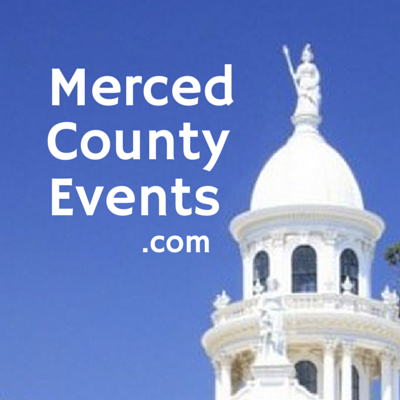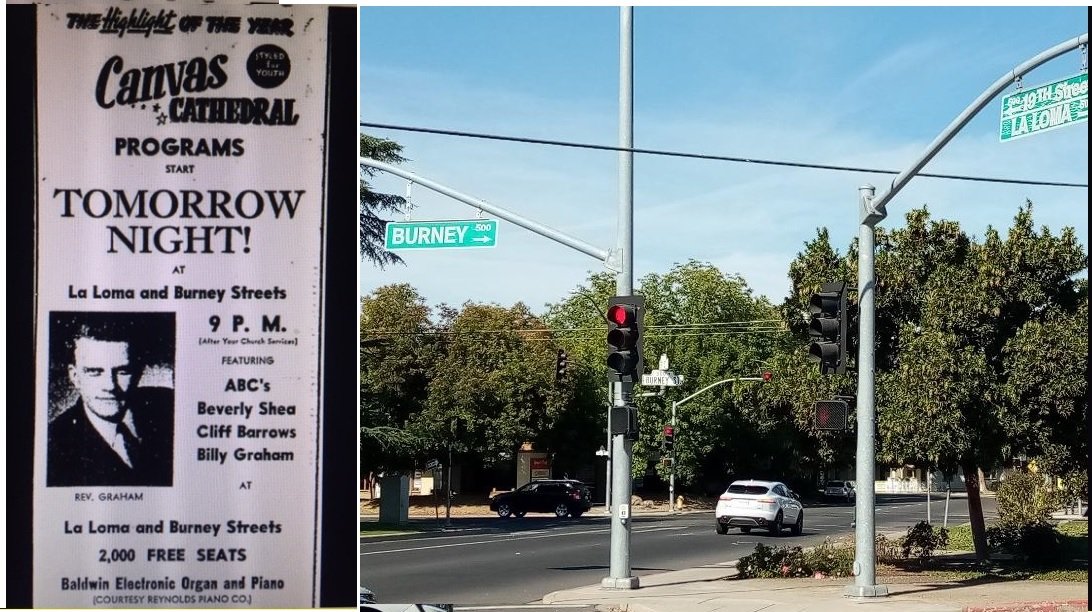’48 Modesto Crusade Still Reaping Benefits-
75th Anniversary of Billy Graham's Visit to the Central Valley
A poster promoting the Modesto revival meeting with Billy Graham. (right) The intersection of LaLoma Street and Burney Avenue in Modesto where the 1948 revival meetings were held.
October 24, 1948, was a Sunday. A large canvas tent set up in a rural Modesto field was about to be filled with over two thousand people.
For the next two weeks, that tent would fill up every night with more people coming out to hear a special young man speak.
They were there to see a Southern Baptist minister who would preach the Bible by night, and work with his close associates by day to write the rules for a newly formed evangelical organization.
The evangelist was Billy Graham and he was on the precipice of becoming a world-known religious leader. Eleven US presidents would call upon him for spiritual comfort. More than a billion people would hear him preach.
The seventy-fifth anniversary of what became known as the Modesto Crusade was recently noted with little to no fanfare anywhere.
But what took place there three-quarters of a century ago was truly remarkable.
The Crusade ran for two weeks with an estimated twenty-eight thousand people taking part. It was important to the Graham ministry on three fronts: national prominence, the Modesto Manifesto, and the Modesto Gospel Mission.
Pictures from the actual Modesto Crusade are hard to come by. Here is a promotional photo from the Los Angeles Crusade that followed several months after the Modesto stop. Photo: Billy Graham Evangelistic Association
National prominence
The event was an important step that would propel the organization into the national scene. The two-week Modesto Crusade was among the last Graham would lead before heading to Los Angeles.
The Los Angeles Crusade in 1949 would run for eight weeks and bring his preaching to over three hundred thousand people. After the success of the Southern California crusade, the stage was set for a worldwide public ministry.
Modesto Manifesto
A key accomplishment from the Modesto Crusade is what Graham and three of his associates worked on during the day throughout the duration of the event.
Working from the former Rock Motel on the old Highway 99 in Modesto, the team wrote a set of four principles they would call the Modesto Manifesto.
The principles spelled out in the Modesto Manifesto are:
Accountability-transparency in reporting finances and Crusade attendance
Purity-specifically addressing sexual immorality. This led to a directive that no one working for the Graham organization be allowed to have a closed-door meeting with someone from the opposite sex.
Integrity-no criticism of local churches or local pastors
Humility-no seeking out “exaggerated publicity” for the crusade events
A key player in writing the Modesto Manifesto was Billy Graham’s close friend Cliff Barrows.
Barrows grew up in nearby Ceres, Stanislaus County. He went to work with Graham when the preacher hired him to fill a music minister post prior to a revival meeting in North Carolina.
Barrows suggested the Modesto stop hoping that his connections with local churches would make a Central Valley crusade successful. As part of Graham's inner circle, he took part in those daily sessions where the core principles were discussed.
Barrows coined the term Modesto Manifesto.
Two of the early locations of the Modesto Gospel Mission. (lower left) The organization is now on Yosemite Avenue in the City. (lower right) An early sign for the Mission. Archive photos: Modesto Gospel Mission archives.
Modesto Gospel Mission
A continuing example of what made the 1948 Modesto Crusade a success is what was done with excess funds raised from the nightly offerings attendees gave.
With an estimated five thousand dollars from excess offerings from the Crusades, local pastors started the Modesto Gospel Mission.
“There was homelessness in 1948 just like we have now seventy-five years later,” said Modesto Gospel Mission Chief Executive Officer Jason Conway. “Back then, it was more transitory with men coming into Modesto riding in on a boxcar of a train.”
Jason said in the early years, the Mission’s primary work was that of a soup kitchen. “Most of the visitors would get a meal and then move on. Some might stay a day or two, and then they would be on their way.”
That 1948 model has changed a lot. Today, the Mission annually serves nearly a quarter-million meals, shelters about eighteen hundred men, and does the same for over two hundred women and children.
“Today, residency is the focus on most of Modesto’s homeless,” Jason said. “Our clients come here with the intention of staying in the area. That wasn’t the case in 1948.”
This cross sign has been in front of the Modesto Gospel Mission in many of the locations where the organization has been housed. It is now attached to the main building at 1400 Yosemite Avenue in the City.
This effort was made possible because a group of Central Valley pastors invited Billy Graham to bring his revival meetings to Modesto some seventy-five years ago.
There’s no memorial to the Central Valley’s role in the development of the Billy Graham Evangelistic Organization.
While one can find a bronze rendering of the American Graffiti era honoring native son George Lucas, no such memorial exists for that extraordinary two weeks back in October and early November in 1948 when the Modesto Crusade captured the attention of thousands.
But there is what can be considered a memorial to the Billy Graham visit in the work of the Modesto Gospel Mission.
Founded right after the Graham visit, the organization marks a seventieth-fifth year of service along with the Modesto Crusade.
The Mission feeds the hungry, houses the homeless, and helps families throughout the city.
From that five-thousand-dollar investment in human service made possible by the 1948 Modesto Crusade, a living tribute to the work of Billy Graham continues to reap dividends to countless numbers of people who over the years have needed a handout and possibly a hand up in turning their lives around.
It is the living testament to the Manifesto tenet dealing with working with local churches.
It is the true memorial to a historic event in the Central Valley.
Steve Newvine lives in Merced.
He is available for public speaking events at service clubs and other organizations to discuss his new book Beaten Paths and Back Roads.
The book is available for purchase at the Merced County Courthouse Museum gift shop or online at BEATEN PATHS AND BACK ROADS (lulu.com)
For more information on the Modesto Gospel Mission, go to MyMission.org






To explore Steve Newvine's complete collection of books, simply click on the link below.
CLICK HERE
Steve is also open to delivering speeches for service club programs and other public speaking engagements.
Contact him at: SteveNewvine@sbcglobal.net